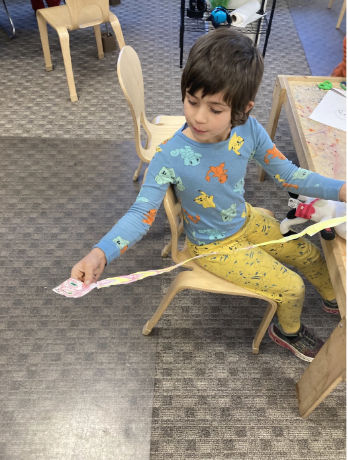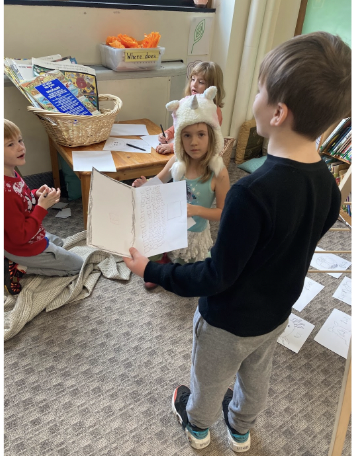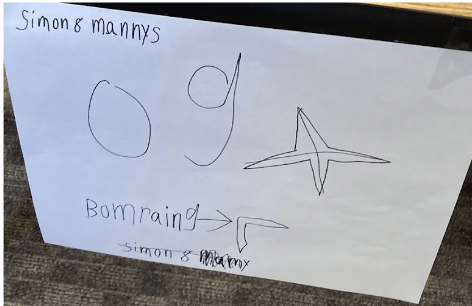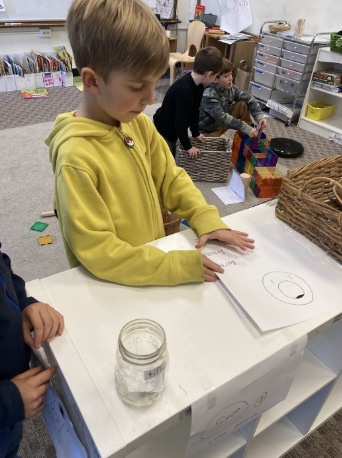Emergent Curriculum
Emergent curriculum is a dynamic and flexible approach to teaching that builds on the interests, ideas, and needs of students. Here’s an example of how emergent curriculum developed in a 1st/2nd grade classroom:
What might the children lean into when we allow them to lead the way?
During inquiry one day I noticed Aela and Chloe starting a shop in the library area. I remembered at the end of last year Chloe was interested in making a shop to sell her creations which was inspired by the older grade students having shops. I decided to take a photo of their shop and show it to the class before our next inquiry time. Aela and Chloe were excited to share about their shop, “Our shop sells drawings for fake money!”
Their enthusiasm for their shop inspired River, Charles, and Ellie to open another drawing shop. I took a photo of the second shop and again showed it to the class while the owners shared about their shop. By the second day the majority of students had decided to open up a shop or become employees at an already opened shop.
At this time I recognized that something unique was taking place. Students were choosing to work on their shops during inquiry rather than doing anything else. Students were collaborating in authentic and genuine ways. They were helping each other build their shops and doing lots of negotiating in the process. After a couple weeks of working on their city every day during our shorter inquiry times students decided they would rather have a larger chunk of time one day a week. Students came up with “Marketplace Wednesdays”.
Now, on Wednesdays we gather in the morning and through photographs, videos, and sharing we remember what students worked on last time together and then I bring forth a wondering for them to consider. For example, we have been learning about currency in math. One week I wondered what they might use for currency in their city. During that marketplace time a student created the “Axodollar”.
The city continues to evolve each week and acts as a processing space for so many things: advocacy, creating safe spaces, building, managing money, entrepreneurship, citizenship, etc. What wonderous things can occur in a classroom when we, as educators, take time to simply slow down, observe what the children are doing, and reflect it back to them.
Day 1
Chloe and Aela start a drawing shop where students can buy their drawings.
An inspired River, Ellie, and Charles open up another store.
Day 2
"We could make a city!"
"We could make a city!"
〰️
"We could make a city!" "We could make a city!" 〰️
Over the course of the next few days more shops open up, some close. and some evolve. Children begin interacting with each other’s shops. Winston opens a “cewt drawings” shop. Manny and Simon open an origami shop. Charles opens and works on building an entrance to a pet shop. Atticus sends virtual money to a shop, “I just sent you $1,000… it’s in your online account.” River makes pets for the pet shop. Layla (who has an art shop herself) goes shopping to support another artist at Ellie’s Spirit Animal Mall.
And then…
After many shops have been set up, students begin to work through some social issues through their city play.
Bandits begin stealing things in the city.
How might we help people feel welcome in our city?
Eloise helps to make our city sign more inclusive.
“I’m opening a police station to catch the hackers.” -Atticus
“We need to make money, but not too much money. We should take care of the money we have like in the real world.” -Abe
**Hugh creates the Axodollar which is adopted as the form of currency.**
“Is there anyone in the city who finds lost pets?” -Charles
“We need somebody to be in charge. We should have a mayor!”
**Chloe is elected mayor of Axolotls of the North.**
At this point, Hannah and I began to collaborate and students were able to do some deeper work/projects for their city during their studio time as well.
As we talked more about how to welcome visitors into our city Atticus and River thought it might be important for a visitor to know where the shops are in the city. So they created a map. “We’re making a map so people know where to go!” they said. During studio time they first made a smaller map and then decided to make a giant one to post right outside the door.
When looking at the map of their city, students wondered if their city would have roads like other city maps they’ve seen. So, they decided to make roads, cars and a traffic light!
Hugh begins offering rides in his taxi and negotiating a fare.
Theo, who has built a traffic light of construction paper, joins the inventors.
Hannah and I collaborated and thought that students might enjoy visualizing their shops and how they might look aesthetically on the outside. We decided to tie this in with map making and prompt the students to create a 3D model of their shops that would then get added to an even bigger, 3D map of Axolotls of the North. The students took a field walk in the neighborhood to observe features of cities, studied aerial images of the Twin Cities to get perspective from all sides, and looked at examples of other “cardboard cities” to find what would be possible.
The students begin drawing sketches for their buildings.
Dietrich and Simon want to add graffiti to their casino building. Dietrich tries his hand at a few design options.
On our walk, Hugh notices that the sun is an important part of a city, because it provides energy for the power lines to send to homes and businesses. He isn’t sure how to make a 3D sphere with cardboard, so he works with Hannah using papier-mache instead.
River designs a powerline for his cardboard birds.
Once they’ve built their buildings,
the students paint them.
At long last, the city map is assembled!
They trace the footprint of their buildings on the map and label where things belong.
Some students add roads and sidewalks, making sure the many spaces of the city are navigable. Ellie remembers the need for traffic lights. Atticus considers the paths through the city: “We need to get crossroads!”
“100 Languages of the Axolotls
“The child
is made of one hundred.
The child has
a hundred languages
a hundred hands
a hundred thoughts
a hundred ways of thinking
of playing, of speaking.”
-Loris Malaguzzi (translated by Lella Gandini)
—————————————-
As an educator, I believe that offering students extended time for open ended play is integral to honoring the 100 languages. As demonstrated in Axolotls of the North, when given the opportunity, students can lean into play with curiosity, collaboration, and creativity and create something that is rich in learning opportunities.”




























